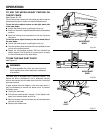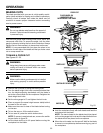
38
39
Æ
Æ
NON-THROUGH CUT
BLADE
GUARD
REMOVED
PUSH STICK
Fig. 61
OPERATION
TO MAKE A NON-THROUGH CUT
See Figure 61.
Non-through cuts can be made with the grain (ripping) or
across the grain (crosscut). The use of a non-through cut is
essential to cutting grooves, rabbets, and dadoes. This is the
only type cut that is made without the blade guard assembly
installed. Make sure the blade guard assembly is reinstalled
upon completion of this type of cut. Read the appropriate
section which describes the type of cut in addition to this
section on non-through or dado cuts. For example, if your
non-through cut is a straight cross cut, read and understand
the section on straight cross cuts before proceeding.
WARNING:
Unplug the saw to prevent accidental starting
that could result in possible injury.
n Remove the blade guard assembly.
n Turn the bevel lock lever to the right to unlock it then turn
the bevel adjusting handwheel until the bevel indicator is
at the desired angle.
n Set the blade to the correct depth for the workpiece and
push the bevel lock lever to the left to relock it. Retighten
the blade height lock knob.
n Plug the saw into the power source.
n Feed the workpiece into the blade.
n Always use push blocks, push sticks, and featherboards
when making non-through cuts to avoid the risk of serious
injury.
WARNING:
When making a non-through cut, the cutter is
covered by the workpiece during most of the
cut. Be alert to the exposed cutter at the start
and finish of every cut to avoid the risk of serious
personal injury.
WARNING:
Never feed wood with your hands when making
any non-through cut such as rabbets or dadoes.
Always use push blocks, push sticks, and feather
boards.
n When the cut is made, turn the saw off. Wait for the blade
to come to a complete stop before removing any part of
the workpiece.
Once all non-through cuts are completed:
n Unplug your saw.
n Lower the blade and reinstall the blade guard assem-
bly.


















